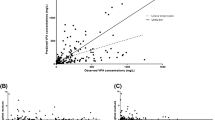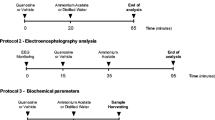Abstract
Dose-response curves for the incidence of coma after intraperitoneal injections of various doses of valproic acid (VP) and octnoic acid (OA) showed that, mole for mole, valproic acid was less toxic than octanoic acid. However, a simultaneous subcoma dose of pentobarbital (PB) enhanced the toxicity of VP more than that of OA. The dose-response curve for NH4C1 was affected by simultaneous subcoma doses of VP and OA but not by PB. VP enhanced the toxicity of the NH +4 by 52%; OA enhanced the toxicity by 12%. PB added significantly to the toxicity of VP and NH +4 when the three were given simultaneously. Doses of 0.7 mmol NH +4 and 0.5 mmol VP given separately had little or no encephalopathic effect, with blood ammonias of 250–1250μg/dl. When given simultaneously they induced a deep coma and raised the blood ammonia threefold, to about 3600μg/dl. Similar doses of OA and NH +4 , induced a similar deep coma, but blood levels of ammonia were not as high. Simultaneous injections of 250 mg glucose did not alter the results. Thus VP toxicity is enhanced substantially by its synergistic interactions with PB and the NH +4 .
Similar content being viewed by others
References
Coude, F. X., Grimber, G., Parvy, P., Rabier, D., and Petit, F. (1983). Inhibition of ureagenesis by valproate in rat hepatocytes. Role of N-acetyglutamate and acetyl-CoA.Biochem. J. 216: 233–236.
Jezequel, A. M., Bonazzi, P., Novelli, G., Venturini, C., and Orlandi, F. (1984). Early structural and functional changes in liver of rats treated with a single dose of valproic acid.Hepatology 4: 1159–1166.
Kesterson, J. W., Granneman, G. R., and Machinist, J. M. (1984). The hepatoxicity of valproic acid and its metabolites in rats. I. Toxicologic, biochemical and histopathologic studies.Hepatology 4: 1143–1152.
Rumbach, L., Warter, J. M., Rendon, A., Marescaux, C., Micheletti, G., and Waksman, A. (1983). Inhibition of oxidative phosphorylation in hepatic and cerebral mitochondria of sodium valproatetreated rats.J. Neurol. Sci. 61: 417–423.
Turnbull, D. M., Bone, A. J., Bartlett, K., Koundakjian, P. P., and Sherratt, H. S. A. (1983). The effects of valproate on intermediary metabolism in isolated rat hepatocytes and intact rats.Biochem. Pharmacol. 32: 1887–1892.
Warter, J. M., Imler, M., Marescaux, C., Chabrier, G., Rumbach, L., Micheletti, G., and Krieger, J. (1983a). Sodium valproate-induced hyperammonemia in the rat: Role of the kidney.Eur. J. Pharmacol. 87: 177–182.
Warter, J. M., Marecaux, C., Brandt, C., Rumbach, L., Micheletti, G., Chabrier, G., Imler, M., and Kurtz, D. (1983). Sodium valproate associated with phenobarbital: Effects on ammonia metabolism in humans.Epilepsia 24: 628–633.
Warter, J. M., Marescaux, C., Chabrier, G., Rumbach, L., Micheletti, G., Reitzer, B., Hirsch, E., and Imler, M. (1984). Increase of valproate-induced hyperammonemia in normal subjects by carbohydrate intake.Neurology 34: 1487–1489.
Zieve, F. J., Zieve, L., Doizaki, W. M., and Gilsdorf, R. B. (1974). Synergism between ammonia and fatty acids in the production of coma: Implications for hepatic coma.J. Pharmacol. Exp. Ther. 191: 10–16.
Zieve, L. (1985). Encephalopathy due to short and medium-chain fatty acids. In McCandless, D. W., (ed.),Cerebral Energy Metabolism and Metabolic Encephalopathy, Plenum Press, New York, pp. 163–177.
Zimmerman, H. J., and Ishak, K. G. (1982). Valproate-induced hepatic injury: Analysis of 23 fatal cases.Hepatology 2: 591–597.
Author information
Authors and Affiliations
Rights and permissions
About this article
Cite this article
Zieve, L., Lyftogt, C. Valproic acid induction of coma in rats: Synergism with NH +4 and pentobarbital. Metabolic Brain Disease 4, 105–111 (1989). https://doi.org/10.1007/BF00999388
Received:
Accepted:
Issue Date:
DOI: https://doi.org/10.1007/BF00999388




